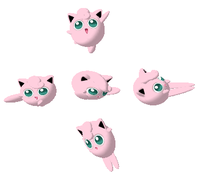Jigglypuff (SSBM)
| Jigglypuff in Super Smash Bros. Melee | |
|---|---|
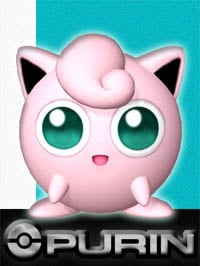 
| |
| Universe | Pokémon |
| Other playable appearances | in SSB in Brawl in SSB4 |
| Availability | Unlockable |
| Tier | A (5) (North America) A (4) (Europe) |
| “ | Jigglypuff's normal attacks are weak, and because of its light weight it's easily sent flying. However, with its incredible midair agility, it seems to dance when airborne. | ” |
| —Description from Jigglypuff's trophy. | ||
Jigglypuff, (プリン, Purin), is an unlockable character in Super Smash Bros. Melee from the Pokémon series, making a return from the first Super Smash Bros game. Jigglypuff retains most of its moves from Smash 64, though with some modifications.
Jigglypuff is in the A tier at 5th place on the Melee tier list, a significant improvement from its 6/12 position on the previous game's tier list, and its best rank in the series. Jigglypuff's jump on the tier list is due to its incredible recovery, an extremely dangerous edgeguarding technique in the wall of pain, a powerful KO move that can easily be comboed into, and an overall great aerial game and developed metagame. Its floatiness also makes it the only character in the top tier who cannot be easily comboed or chaingrabbed, which is also aided by its small size, which allows Jigglypuff to avoid most KO setups that most other characters would fall vulnerable to. Regardless, Jigglypuff still has problems. It is light and floaty, making it easier to KO with stray moves or certain low percentage setups than other characters. Jigglypuff's options on the ground are also limited, because of its poor range and a lack of a projectile. It also has a slow walking speed and dashing speed. Compounded with a poor dash dance, Jigglypuff's neutral game, which is largely committal, is not as good as that of other top-tiered characters; instead, it relies on its lethal punishes, edgeguards, and aerial mobility to succeed. Recent developments in the Melee metagame have also worsened Jigglypuff's matchups against other top-tier characters, such as Fox, Marth, and Falco. Despite this, Jigglypuff still has an amazing number of winning matchups, with Fox being the only character in the game it loses to, plus it has even matchups with only three other characters.
How to Unlock
To unlock Jigglypuff, Complete Classic Mode or Adventure Mode on any difficulty.
Jigglypuff is fought on Pokémon Stadium, with the titular track playing.
Attributes
Jigglypuff is, in general, a character of extremes. It has the slowest dash speed (tied with Zelda), the fastest air speed, the second lightest weight (along with Mr. Game & Watch), and the slowest falling speed. All of these properties gives Jigglypuff among the most unusual, but versatile, approach in the game.
Owing to its unusual properties, Jigglypuff is among the hardest characters to combo in the cast. Jigglypuff's light weight and floatiness make it insusceptible to the majority of extended combos, such as zero-to-death combos and chaingrabs; after only a few hits, Jigglypuff will already be sent too far to chase down before the hitstun wears off, without the gravity needed to pull it back down to continue the combo. Additionally, Jigglypuff's small frame and short crouch allow it to duck under certain hitboxes, such as several characters' standing grabs, and its fast air speed and floatiness allow it to weave away from improperly spaced attacks. These properties make it difficult for characters who rely on combos, such as Sheik and Captain Falcon, to get those combos and KO setups that allow them to succeed in other matchups.
On the other hand, however, Jigglypuff possesses outstanding combo ability itself; with high hitstun, low knockback aerials, good tilts, and average power throws, Jigglypuff has plenty of ways to start and continue combos against almost any other character in the game, regardless of the opponent's characteristics. Jigglypuff also possesses KO setups of its own, including the space animal slayer, which almost guarantees a KO against some fast fallers in the game. Jigglypuff also has incredible power in some of its attacks; its smash attacks, particularly forward smash, can KO at realistic percentages. Jigglypuff's most powerful attack, however, is Rest. Among the most feared attacks in the game, Rest is an attack of extremes, with no starting lag (hitting on the very first frame), extreme ending lag, and incredible power, easily KOing characters at percentages as low as 25%. All of these powerful moves can be comboed into or used in tech chasing, giving them significant utility.
Due to its characteristics and recovery prowess, Jigglypuff is also among the most dangerous edgeguarders in the game. It possesses several ways to set up an edgeguard, including its down smash and back throw; once offstage, Jigglypuff can finish the opponent with its quick and powerful aerials that are easily able to disrupt most recoveries off-stage, and the aforementioned high-power moves such as Rest that heavily punish improper recoveries done onto the stage. Jigglypuff's Wall of Pain is a particularly lethal method of edgeguarding, as it is an off-stage combo that can guarantee KOs on characters with poor recoveries, such as Falco and Roy, if done properly. Jigglypuff's edgeguarding is also much more flexible compared to other characters', due to its superior aerial drift, as it can easily cover both on- and off-stage options while other strong edgeguarding characters cannot. These strengths make Jigglypuff arguably the strongest edgeguarder in the game. On the flip side, Jigglypuff's own recovery is also considered to be the best in the game; with five midair jumps, the lowest falling speed, and the highest air speed, Jigglypuff can recover from nearly any situation, as Pound, with its Rising Pound capabilities, gives Jigglypuff almost infinite vertical and horizontal distance. Its ability to weave in and out of enemy aerials, as well as its nearly unmatched number of jumps, make Jigglypuff extremely difficult to edgeguard.
Jigglypuff, however, is among the easiest characters to KO; due to having the second lowest weight in the game (along with Mr. Game & Watch, and second to Pichu), as well as its general floatiness, Jigglypuff is very vulnerable to all blastlines, particularly the upper lines. While Jigglypuff is immune to most KO setups, the few setups that characters do have against it can prove overwhelming in their corresponding matchups. For example, Fox is considered to hard counter Jigglypuff because unlike other characters, he possesses several KO setups against Jigglypuff, including jab to up smash and a timely up throw to up aerial, and the speed to effectively challenge Jigglypuff's aerial drift.
Additionally, Jigglypuff's ground approach is among the worst in the game; it has a short wavedash, the slowest dash in the game (alongside Zelda), and an average grab range, forcing Jigglypuff to stay in the air to attack and combo well. Additionally, Jigglypuff's shield delivers 300 points of vertical knockback to Jigglypuff when broken (by comparison, the typical smash attack at roughly 100% percentage deals about 165 to 195 points of knockback), and instantaneously KOs it, giving it another defensive disadvantage when grounded. Despite having almost unparalleled approach in the air, being in the air is an inherent disadvantage in the neutral game, as Jigglypuff lacks access to grounded defensive options such as shielding and dodging, forcing Jigglypuff to play patiently and wait for opponents to overextend most of the time. Thus, if Jigglypuff misspaces or mistimes a single aerial, opponents can simply hit it out of the air, leading to lost stage control or even a stray KO at higher percentages. Jigglypuff also lacks a projectile of any type; unlike other characters, such as Marth, Jigglypuff also cannot negate projectiles easily, though its short crouch can mitigate this slightly. This makes Jigglypuff susceptible to being locked down or zoned out by projectile users, such as Falco and Young Link.
Overall, Jigglypuff has polarizing strengths and weaknesses. Jigglypuff has one of the most potent punish games out of all characters, yet is immune from most other characters' punishes; additionally, it cannot easily be edgeguarded, but is an extremely strong edgeguarder itself. On the other hand, Jigglypuff is KOed easily from stray hits unlike other characters, and struggles to approach enemies due to its decidedly below-average neutral game, making it difficult to get openings in competitive play. Skilled players should take into account these weaknesses, using clever baits and capitalizing on opponents' mistakes to attain superior positions where Jigglypuff can disrupt the opponent's plan and secure KOs that cannot easily be escaped from.
Changes from Smash 64 to Melee
When transitioning from Smash 64 to Melee, Jigglypuff received multiple buffs, primarily in regards to its power, speed, range, combo ability, and recovery. Tournament results demonstrate this, and Jigglypuff went from 6th out of 12 on the Smash 64 tier list to 5th out of 26 on the Melee tier list. As a result of these improvements in both tournament and tier placings, Jigglypuff is widely considered one of the most buffed characters in the game, alongside Samus.
Aesthetics
 Jigglypuff received a new taunt, where it now spins in place while winking at the player.
Jigglypuff received a new taunt, where it now spins in place while winking at the player. Its "applause" pose on the Results Screen now properly loops, instead of merely moving its head twice and then stopping.
Its "applause" pose on the Results Screen now properly loops, instead of merely moving its head twice and then stopping.
Attributes
 Jigglypuff's air speed is much faster (35 → 1.35), from the fourth fastest in Smash 64 to the fastest in Melee, largely improving Jigglypuff's approaching, combo ability, and recovery potential.
Jigglypuff's air speed is much faster (35 → 1.35), from the fourth fastest in Smash 64 to the fastest in Melee, largely improving Jigglypuff's approaching, combo ability, and recovery potential. Jigglypuff's midair jumps now all give height, also greatly improving its recovery.
Jigglypuff's midair jumps now all give height, also greatly improving its recovery. Dashing speed reduced to being the slowest in Melee, along with Zelda (42 → 1.1).
Dashing speed reduced to being the slowest in Melee, along with Zelda (42 → 1.1). Jigglypuff's walking speed is much slower (0.28 → 0.7), hindering its already poor approach.
Jigglypuff's walking speed is much slower (0.28 → 0.7), hindering its already poor approach. Jigglypuff is significantly heavier (53 → 60), improving its endurance but making it easier to combo.
Jigglypuff is significantly heavier (53 → 60), improving its endurance but making it easier to combo. Jigglypuff is floatier (38 → 1.3), which hinders its endurance, but making it harder to combo.
Jigglypuff is floatier (38 → 1.3), which hinders its endurance, but making it harder to combo.
Ground attacks
 Up tilt has higher base knockback, improving its combo ability at low percentages.
Up tilt has higher base knockback, improving its combo ability at low percentages. Up tilt deals less damage (10% → 9%/8%), and has less range, which combined with the previous point hinders its juggling potential.
Up tilt deals less damage (10% → 9%/8%), and has less range, which combined with the previous point hinders its juggling potential. Down tilt has more range and less startup lag, improving its spacing potential.
Down tilt has more range and less startup lag, improving its spacing potential. Forward smash deals significantly stronger damage and knockback, going from the second weakest in Smash 64 to the sixth most powerful in Melee.
Forward smash deals significantly stronger damage and knockback, going from the second weakest in Smash 64 to the sixth most powerful in Melee. Up and down smashes have slightly less startup lag.
Up and down smashes have slightly less startup lag. Up smash deals much less knockback and has considerably more ending lag.
Up smash deals much less knockback and has considerably more ending lag. Up smash now deals consistent damage (18% (clean)/10% (late) → 14%).
Up smash now deals consistent damage (18% (clean)/10% (late) → 14%).
Aerial attacks
 All aerials deal weaker damage and knockback, increasing their combo ability, but reducing their KOing and edgeguarding potential.
All aerials deal weaker damage and knockback, increasing their combo ability, but reducing their KOing and edgeguarding potential. Forward and back aerials have more range, especially back aerial, making them better for approaching.
Forward and back aerials have more range, especially back aerial, making them better for approaching. Down aerial no longer meteor smashes aerial opponents, significantly hindering its edgeguarding potential.
Down aerial no longer meteor smashes aerial opponents, significantly hindering its edgeguarding potential.
Grab and throws
 Jigglypuff has been given a up throw, a down throw, and a pummel, improving its grab options.
Jigglypuff has been given a up throw, a down throw, and a pummel, improving its grab options. Forward throw from Smash 64 moved to up throw in Melee.
Forward throw from Smash 64 moved to up throw in Melee.
Special attacks
 Jigglypuff has a new neutral special: Rollout. It's a chargeable move that deals good damage, can KO early regardless of where the opponent is on the stage, and moves at fast speeds when fully charged.
Jigglypuff has a new neutral special: Rollout. It's a chargeable move that deals good damage, can KO early regardless of where the opponent is on the stage, and moves at fast speeds when fully charged. Pound is now a side special due to Rollout now becoming its neutral special.
Pound is now a side special due to Rollout now becoming its neutral special. Pound sends opponents on a different trajectory that gives it more favourable combo ability. Rising Pound is also much easier to perform, another improvement of Jigglypuff's recovery.
Pound sends opponents on a different trajectory that gives it more favourable combo ability. Rising Pound is also much easier to perform, another improvement of Jigglypuff's recovery. Sing now puts opponents to sleep for longer at higher percentages, instead of putting opponents to sleep for longer at lower percentages like in Smash 64.
Sing now puts opponents to sleep for longer at higher percentages, instead of putting opponents to sleep for longer at lower percentages like in Smash 64. Sing can be ledge-cancelled, which can occasionally set up a Rest for careless edgeguarders, which is further complemented by the move now putting opponents to sleep for longer st high percentages. Additionally, it gives a slight vertical boost in midair if jumped and can now grab ledges, granting it recovery potential.
Sing can be ledge-cancelled, which can occasionally set up a Rest for careless edgeguarders, which is further complemented by the move now putting opponents to sleep for longer st high percentages. Additionally, it gives a slight vertical boost in midair if jumped and can now grab ledges, granting it recovery potential. Due to Sing putting opponents to sleep for longer at higher percentages, the move is a less reliable setup option at low percents.
Due to Sing putting opponents to sleep for longer at higher percentages, the move is a less reliable setup option at low percents. Rest deals significantly more knockback and damage (20% → 28%) and there is a larger variety of ways to combo into it, including the aforementioned Sing.
Rest deals significantly more knockback and damage (20% → 28%) and there is a larger variety of ways to combo into it, including the aforementioned Sing. Rest has a slightly smaller hitbox.
Rest has a slightly smaller hitbox.
Moveset
For a gallery of Jigglypuff's hitboxes, see here.
| Name | Damage | Description | ||
|---|---|---|---|---|
| Neutral attack | 3% | Two quick jabs with rather poor range. Good for jab resetting and can lead into tilts. | ||
| 3% | ||||
| Forward tilt | 10% | Does a quick roundhouse spin, feet extended. Has short range. Can be angled up or down. | ||
| Up tilt | 9% (clean), 8% (late) | Extends its foot upwards quickly. Relatively good for combos, being able to chain into itself at lower percentages, and is a great setup for an aerial attack at higher percentages. | ||
| Down tilt | 10% | Quickly extends its foot downwards. | ||
| Dash attack | 12% (clean), 8% (late) | A generic dash attack; trips and falls head-first forwards. Somewhat fast and powerful, but is predictable, and has moderate ending lag. | ||
| Forward smash | 17% (clean), 13% (late) | Does a small hop forward with foot extended. Has minor startup and ending lag, but is a decent finisher at higher percentages due to its extremely high knockback scaling; it has the second highest knockback scaling in the game out of the forward smashes, losing only to Luigi's. | ||
| Up smash | 14% | Headbutts upwards. It can be good for leading into aerial combos or finishing, and it can combo into Rest at mid percentages, but due to the ending lag, it isn't too reliable. There is a smaller hitbox in Jigglypuff's head that deals 15% damage but never connects due to overlapping the bigger hitbox. | ||
| Down smash | 12% | Enlarges both its feet sideways. Has a bit of ending lag, but with semi-spike properties, it can be a good edgeguarder. However, Jigglypuff's aerials are usually safer and more reliable. Both of Jigglypuff's feet are intangible the moment the hitboxes come out. | ||
| Neutral aerial | 12% (clean), 9% (late) | Squishes itself and extends its feet. Decent spacing move, and has sex kick properties. Can be good for edgeguarding. | ||
| Forward aerial | 12%/10% (clean feet/body), 7% (late) | Quickly extends both feet in front of itself. It is useful for edgeguarding and is the backbone of many of Jigglypuff's aerial combos, but is not as powerful or reliable as its back aerial. | ||
| Back aerial | 12% | Spins backward and kicks behind itself. This is Jigglypuff's key tool for edgeguarding. It is extremely useful for wall of pain techniques, which can be potentially deadly, and if done correctly, guarantees a KO. It has a particularly large hitbox behind Jigglypuff when it comes out. | ||
| Up aerial | 12% | Waves its arm up in an arch. Decent vertical KO power, and excellent for juggling, compounded with Jigglypuff's multiple midair jumps. Can combo into Rest on its own or after an up throw (usually done at mid-high percentages to ensure that the Rest is landed), especially against fastfallers. | ||
| Down aerial | 2% (hits 1-8) | A downwards drill kick. Not much hitstun. If the player used short hopped down aerial with L-cancel, it can lead to a Rest. Deals 16% damage total if all hits connect. | ||
| Grab | — | |||
| Pummel | 3% | Slaps opponent with its tuft of hair. Somewhat slow. | ||
| Forward throw | 5% (hit 1), 7% (throw) | Puffs itself up and launches foe in front. Surprisingly high knockback compared to most throws in Melee, can lead into an edgeguard KO near the ledge, though not as reliable as its back throw. Second strongest forward throw in Melee. The throw can KO opponents above 130% when used very close to the ledge. | ||
| Back throw | 10% | Similar to Kirby's, takes foe and throws them behind while going on its back. A very good and reliable option for forcing opponents offstage, setting up an edgeguard. | ||
| Up throw | 11% | Spins once and tosses opponent upwards. Can lead into aerial combos against fast fallers and lightweights or floaty characters at low percentages. At low percentages against fastfallers, it can combo into Rest; at mid percentages, an up aerial can be added to ensure that the Rest is landed, as stated above. | ||
| Down throw | 1% (hits 1-4), 3% (hit 5), 2% (throw) | Grinds opponent with itself on the floor. Can combo into Rest against floaty characters. | ||
| Forward roll Back roll Spot dodge Air dodge |
— | — | ||
| Techs | — | — | ||
| Floor attack (front) Floor getups (front) |
8% (foot), 6% (body) | Spins one leg around while getting up, kicking behind then in front of itself. | ||
| Floor attack (back) Floor getups (back) |
8% (foot), 6% (body) | Spins one leg around while getting up, kicking behind then in front of itself. | ||
| Edge attack (fast) Edge getups (fast) |
6% | Gets up onto the stage, foot extended. | ||
| Edge attack (slow) Edge getups (slow) |
6% | Slowly gets up and spins its body in a similar fashion to its d-smash. | ||
| Neutral special | Rollout | 10-18% | Charges up and rolls very fast in one direction. Can turn around by tapping the control stick in the opposite direction. If the move is uncharged, it doesn't do any damage (unless the opponent is close to Jigglypuff the moment it starts rolling), but it gets more powerful and faster the more it is charged, with KO potential when fully charged. However, due to being predictable and easy to dodge (it can be jumped over, spot dodged, and even shield grabbed), it is rarely used in competitive play. It can be used for recovery as long as Jigglypuff grabs onto the ledge, but otherwise it makes it helpless, and there are almost always better options available. | |
| Side special | Pound | 13% | Extends a fist forward, knocking opponents up and behind Jigglypuff. Does high knockback, especially at low percentages, and has a long lasting hitbox. It also deals 20 shield damage, which is fairly high for an attack. Pound is mainly used as a recovery move - it can be angled up and down, the former referred to as Rising Pound, which, combined with Jigglypuff's five midair jumps, extremely fast air speed, and extremely low falling speed, give it a gigantic recovery. | |
| Up special | Sing | 0% | Sings, sending opponents nearby to sleep. However, it has extremely low range and the opponent can often wake up before Jigglypuff finishes singing. The sing time can be cancelled if Jigglypuff grabs onto the ledge, with the opponent falling asleep (leaving them vulnerable), but that isn't effective due to the move's such low range. Overall, the move is near useless. | |
| Down special | Rest | 28% | Rests. Normally, this leaves Jigglypuff very vulnerable, but there is a very small hitbox located near its eyes, which deals extremely high damage and knockback, being able to KO reliably at as low as 25%. Can easily be combo'd into with a variety of moves, notably its up throw, up aerial, up tilt, and down throw. It is among the most feared attacks in the game due to its extreme power and instantaneous startup, but if it misses, it leaves Jigglypuff extremely vulnerable. Most useful in teams matches where a teammate can cover Jigglypuff's extreme ending lag upon using Rest with a jab. Deals flame damage. | |
Taunt
- Spins around on one foot, then looks at the camera inflated, winking and saying "Jigglypuff!" The eye Jigglypuff winks depends on which side it's facing.
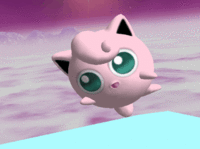
|
Idle pose
- Looks at its side while jumping.
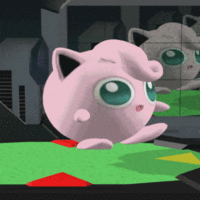
|
|---|
Crowd cheer
| English | Japanese | |
|---|---|---|
| Cheer | File:Jigglypuff Cheer NTSC Melee.ogg | File:Purin Cheer JP Melee.ogg |
| Description | Jig-gly-puff! | Puh-riiin! |
| Pitch | Male | Male |
Victory poses
- Hestitates for a while, then jumps up and lands on its back.
- Jumps twice, then does a backflip.
- Sleeps, then suddenly wakes up.
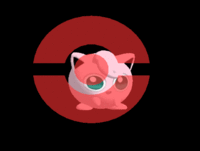 |
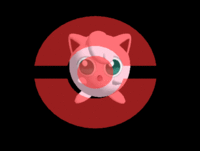 |
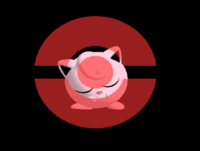
|
|---|
In Competitive play
Matchups
| Avg. | |||||||||||||||||||||||||||
Jigglypuff has one of the most positive matchup spreads in the game, though it hard counters fewer low-tier characters than most of the other top-tiers. It is soft countered by one character, has even matchups with three, soft counters nine, counters ten, and hard counters two. Jigglypuff generally has an advantage against characters with poor or telegraphed recovery options, such as Captain Falcon, Sheik, Marth, Ganondorf, and Mario. It also has an advantage against characters who do not have reliable KO setups against it due to its light weight and floatiness, such as Peach. Jigglypuff struggles against characters with strong vertical KO options, most notably Fox's up smash and up aerial, and also has some trouble against characters who can use projectiles to disrupt Jigglypuff's approach options, such as Falco and Dr. Mario. Despite these flaws, Jigglypuff's amazing edgeguard and punish game give it positive matchups against almost all of the cast.
In the modern metagame, however, professionals have adapted to Jigglypuff's toolset. Due to the general increased technical ability and patience among Fox professionals, Fox is now considered a true counter to Jigglypuff, even on Jigglypuff's best stages such as Dream Land. Marth is also now considered to have an even or advantageous matchup against Jigglypuff; Marth professionals such as PewPewU and PPMD have adopted a wide variety of new KO setups and approach options while more readily abusing his superior neutral game, utilizing previously unexplored or obscure advanced techniques. Thus, although Jigglypuff still has an advantage against most of the cast and retains a powerful punish game, its advantages over some top tiers have diminished over time.
Notable players
- See also: Category:Jigglypuff professionals (SSBM)
Active
2Saint - Ranked 12th on the NYC Metropolitan Area Melee Power Rankings, 100th on the 2017 SSBMRank.
4% - He is ranked 99th on the 2016 SSBMRank and 1st on the Northeast Ohio Melee Power Rankings.
Dudutsai - The best active New England Jigglypuff player, placing 49th at EVO 2016, 33rd at Shine 2016, 37th at MLG Anaheim 2014 and 17th at Get On My Level 2014.
Hungrybox - One of the Five Gods. The best Jigglypuff player in the world; 1st on the 2017 SSBMRank.
Idea
K.F
Legend
Prince Abu - The second best Jigglypuff in the world, ranked 42nd on the 2016 SSBMRank. Placed 9th at EVO 2017.
s0ft
SmashBob SquarePants - Ranked 1st on the South Carolina Power Rankings.
Tekk
Pretty in Pink
Inactive
Darc - Formerly 4th on the New England Power Rankings, he was well-known for very solid placings in doubles such as 2nd at GENESIS, 2nd at Apex 2009. He also placed very well in singles and was at one point a top 20 player in the world, with 13th at GENESIS, 13th at Apex 2010 and 17th at Apex 2014. He is currently on a hiatus and focusing on Project M.
KillaOR
The King - Ranked 14th on the Smash Panel Power Rankings for his performances such as 5th at MLG Dallas 2006, 9th at MLG Anaheim 2006 and 9th at Zero Challenge 2.
Mango One of the Five Gods. It was his first true main, after being inspired by The King.
Raistlin - Placed 9th at GENESIS.
Tier placement and history
Since the beginning of the Melee metagame, Jigglypuff has had among the biggest improvements, going from a lower-mid tier character to a viable top tier character. In the first tier list (October 2002), Jigglypuff was ranked 17-18th place (tied with Ness), but jumped to 10-11th in the second tier list (December 2002). Jigglypuff hovered around the 8th-11th spots before rising to 6th-7th place (tied with Captain Falcon) in the ninth tier list (October 2008), largely due to Mango showing how dominant Jigglypuff was in the air, and how powerful its pressure game and combo abilities were. With Mango continuously dominating more Melee tournaments using Jigglypuff, and the rise of another nationally dominant Jigglypuff player in Hungrybox, Jigglypuff jumped up to top tier in the original 10th tier list (September 2010), tied with Fox and Falco for the top position. In the actual 10th tier list (December 2010), Jigglypuff was ranked third under Fox and Falco. Jigglypuff is ranked 5th place in the twelfth (current) tier list, as of December 2015. Jigglypuff has had a much smaller playerbase than the rest of the top tier characters, with only four representatives on the 2015 SSBM Player Rankings.
PAL viability
Jigglypuff was relatively unchanged from the NTSC version, although it can now take damage from Bowser's down throw due to the changes in its properties, which is not a significant nerf due to Bowser's lack of usage in PAL regions. However, it benefits from the nerfs to some other top-tiered characters, who either lost KO options (Sheik), have decreased aerial drift (Marth) or recovery distance, or a combination of the three (Fox). As such, it is considered slightly better relative to the cast in PAL than in NTSC, and is ranked 4th on the PAL tier list instead of 5th. Jigglypuff's tournament representation in PAL is roughly the same as in NTSC, with a handful of top Jigglypuff mains (notably Hack and Tekk) and a small pool of lower-leveled ones.
In single-player modes
In Classic Mode
Once Jigglypuff is unlocked, it may appear in the game's Classic Mode as a one-on-one, team (alongside Kirby or Pikachu), giant, multi, or metal opponent, as well as an ally in team and giant fights.
In all of its appearances, Jigglypuff appears on Pokémon Stadium; when paired with Kirby in the team battle, it will appear on Green Greens.
In Adventure Mode
Jigglypuff can appear in Stage 7 of the Adventure Mode; in the Pokémon Battle, Jigglypuff can appear among the Pikachus the player has to fight against.
In All-Star Mode
In All-Star Mode, Jigglypuff and its allies are fought on Poké Floats.
In Event Matches
Jigglypuff appears in the following Event Matches:
- Event 32: Target Acquired: As Falco, the player must KO Jigglypuff as many times as possible in one minute on Corneria. However, Arwings also fire frequently at the stage, and Falco must KO Jigglypuff more often than the Arwings to win the event.
- Event 37: Legendary Pokémon: As any character, the player must fight against a team of four Wire Frames and Jigglypuff; everyone has two lives, and the only items that spawn are Pokéballs, all of which only produce legendary Pokémon. Jigglypuff will never directly attack the player, and will instead only pursue Pokéballs when they appear. Defeating all five opponents also gives the player the opportunity to unlock Pichu.
- Event 39: Jigglypuff Live!: As Jigglypuff, the player must fight against a team of three other Jigglypuffs, with friendly fire turned on; all fighters have three lives, and the damage ratio has been increased.
- Event 40: All-Star Match 4: Jigglypuff is the third opponent fought in this series of staged battles. The selected character battles it on the Poké Floats stage with a stock of 2 while Jigglypuff has 1. With a timer of four minutes, the player must defeat it and the other four characters one-by-one with the overall time and damage: Marth, Luigi, Mewtwo, and Mr. Game & Watch.
Ending images
Trophy descriptions
In addition to the normal trophy about Jigglypuff as a character, there are two trophies about it as a fighter, unlocked by completing the Adventure and All-Star modes respectively with Jigglypuff on any difficulty:
- Jigglypuff (Adventure)
- Jigglypuff's normal attacks are weak, and because of its light weight it's easily sent flying. However, with its incredible midair agility, it seems to dance when airborne. Rollout is a powerful speed attack, but be careful not to fly off the edge. Pound does serious damage, and it can also help as a recovery move.
- Jigglypuff (All-Star)
- Jigglypuff can put its enemies to sleep if they are in range of its Sing attack, although the attack does not work on airborne foes. Rest puts Jigglypuff into a deep sleep, but at the instant it drops off, an intense energy force radiates out of the exact center of its body. If this force comes in contact with an enemy, look out! Rest is Jigglypuff's wild card.
Alternate costumes

| ||||
Trivia
- Jigglypuff is one the five hidden characters, along with Ganondorf, Mewtwo, Young Link, and Pichu, to be seen in the opening movie.
- Jigglypuff is the only character who has a different voice actor when the language is switched to Japanese.
- Jigglypuff's and Mr. Game & Watch's stock icons show their entire body; they are the only characters in Melee to have this.
- After picking up a Metal Box, Jigglypuff's eyes disappear.
- Jigglypuff and Luigi are the only unlockable veterans in Melee.
External Links
- Translation of official character page on Source Gaming
- Official character page on the Japanese Melee website
- Are You a Jigglypuff Player? by Kira
| Fighters in Super Smash Bros. Melee | |
|---|---|
| Veterans | Captain Falcon · Donkey Kong · Fox · Jigglypuff · Kirby · Link · Luigi · Mario · Ness · Pikachu · Samus · Yoshi |
| Newcomers | Bowser · Dr. Mario · Falco · Ganondorf · Ice Climbers · Marth · Mewtwo · Mr. Game & Watch · Peach · Pichu · Roy · Young Link · Zelda (Sheik) |
